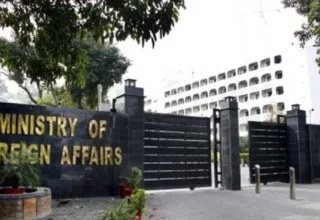
ISLAMABAD – Minister for Planning and Development Makhdoom Khusro Bakhtiar has said the government is making efforts to expand the scope of China Pakistan Economic Corridor (CPEC) and negotiations are underway with China for cooperation in the agriculture sector while industrialization process in Pakistan was also being intensified.

Planning Minister Khusro Bakhtiar
Talking to media here, the minister said government has reduced the current account deficit, left by the outgoing government of Pakistan Muslim League-Nawaz. He said the incumbent government is working to bridge the import-export gap.
Responding to a question, he said a charter of economy is need of the hour and all the parties should rise above their political affiliations for the purpose.
Pakistan and China in later April embarked on the new phase of CPEC by signing memoranda of understanding (MoUs) on the first Special Economic Zone (SEZ) and socio-economic development and a new agreement on free trade.
The MoUs and the second stage Free Trade Agreement (FTA) were signed towards the conclusion of Prime Minister Imran Khan’s second trip to China in six months.
Prime Minister’s visit to Beijing was aimed at attending the second Belt and Road Forum and talks with the Chinese leadership on the expanded CPEC. The earlier visit was more about the future course of the CPEC after the change of government in Pakistan and soliciting Beijing’s help for dealing with the balance of payments crisis.
PM Khan in his meeting with Chinese President Xi Jinping assured him of Pakistan’s “unflinching commitment” to the CPEC and hailed its next phase, which includes newer areas like agriculture, industrial development and socio-economic uplift with livelihood projects.
The contours of the second phase of the CPEC have been finalised in view of priorities of the Pakistan Tehreek-i-Insaf government related to socio-economic projects, greater involvement of the private sector and jobs creation.
President Xi appreciated Pakistan government’s agenda for socio-economic development and people-centred progress.
The new phase of the CPEC would be characterised by industrialisation. The first Special Economic Zone comprising 20 factories is being set up in Rashakai, Khyber-Pakhtunkhwa. The Rashakai SEZ Joint Venture and Licence Agreement was signed between the KP Economic Zones Development and Management Company and the China Road and Bridge Corporation.
Further progress on SEZs would depend on how the Rashakai project progresses. In the next stage, Chinese are planning to cooperate with Pakistan for setting up of a heavy industry SEZ in Dhabeji (Sindh) and a hi-tech SEZ in Islamabad. Chinese investors are, meanwhile, also signing up joint ventures in a local SEZ in Faisalabad.
In his meeting with Chinese Prime Minister Li Keqiang, Imran Khan hoped that Chinese investment in the SEZs would expand Pakistan’s industrial base and diversify its export basket.
The second most important MoU, signed by the two sides, was between the China International Development Cooperation Agency and Pakistan’s Ministry of Planning, Development and Reforms for implementation of the projects under Joint Working Group of the CPEC on socio-economic development. The projects in education, health, human resource development, poverty alleviation, agriculture, and water and irrigation sectors are being sponsored by the Chinese government for which Beijing would spend $1 billion. Twenty seven projects have been identified by the two governments. The PTI government had placed a special emphasis on this element of cooperation.
In view of trade being an important element of the CPEC, the two sides concluded the second stage of the Free Trade Agreement. The new FTA, which was signed after negotiations spanning over seven years, is aimed at strengthening trade ties. Under the new FTA, China would open up 90 per cent of its market for Pakistani goods whereas Pakistan would share 65pc of its market with Chinese exports. This would also help in redressing, to a certain extent, the yawning trade imbalance between the two countries, which stood at $9.7 billion last year.
Premier Li hoped that the conclusion of the second phase of China-Pakistan FTA would give further boost to trade and economic relations between the two countries.
The two sides also signed an agreement on a technical package for upgradation of Pakistan’s main railway line ML-1.
On completion of ML-1, the Pakistan Railways will benefit in terms of increase in speed from 65km per hour to105km per hour to 120km/h to 160 km/h, increase in line capacity from 34 to 171 trains each way per day, increase in freight volumes from six to 35 million tons per year by 2025, increase in passenger trains from 20 to 40 each way per day and increase in railway share of freight transport volume from the current less than 4pc to 20pc.
Under the next phase of the agreement, the ministry of railways and the National Railway Administration of China will jointly start the construction work on the project. Prior to start of work, the final cost of the project would be worked out and agreement of financing would be finalised after considering the available options for financing, a spokesperson of the ministry of railways explained.
The signing of the ‘Declaration for Preliminary Design’ for completion of the first phase of Pakistan Railways’ existing mainline (ML-1) has laid the foundation of cooperation between Pakistan and China in the railways sector.
Other agreements signed during PM Khan’s visit were on setting up of a dry port at Havelian, economic and technical cooperation and cooperation in the field of marine sciences.








